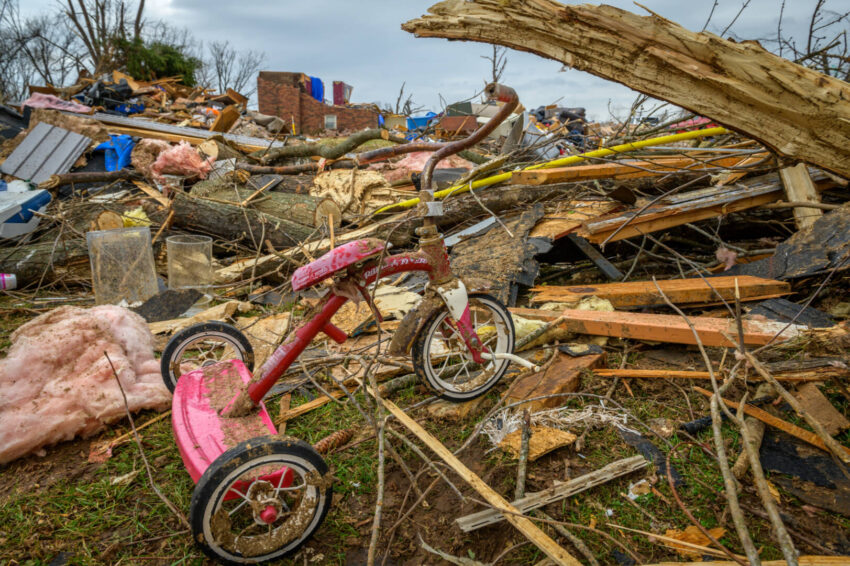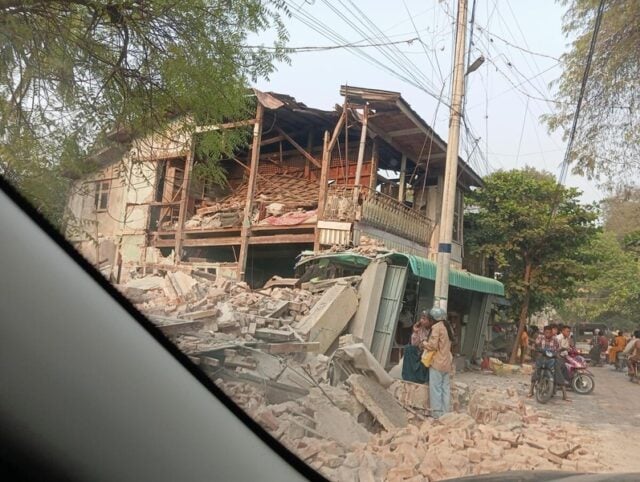A severe weather system swept through the central and eastern U.S., bringing tornadoes, dust storms, high winds, and wildfires. At least 39 people lost their lives, and homes and businesses suffered extensive damage. The system triggered 87 tornadoes, with Mississippi and Missouri among the hardest hit.
Stay informed and prepared to protect yourself and your family. Learn key tornado safety tips and see how World Vision is responding to help affected communities — and how you can make a difference.
Tornadoes: Facts, FAQs, and how to help
- Fast facts: Tornadoes
- What are the latest tornadoes in the U.S.?
- How can I help people affected by disasters in the U.S.?
- What makes tornadoes so destructive?
- What is the rating scale for tornadoes?
- What is an EF5 tornado?
- What are some recent EF5 tornadoes?
- How does World Vision respond to tornado outbreaks?
- How do I prepare for a tornado?
Fast facts: Tornadoes
- A tornado is a rapidly rotating column of air that extends from the base of a thunderstorm to the ground.
- Tornadoes form when warm, moist air collides with cold, dry air, creating unstable atmospheric conditions.
- Twisters can have wind speeds up to over 200 mph (violent tornadoes).
- Tornadoes can vary in size from just a few yards across to more than a mile wide. They usually last for a few minutes to nearly an hour, although some may persist longer.
- The central United States, known as Tornado Alley, is prone to frequent tornadoes due to its geography and climate. It spans from northern Texas to South Dakota, where supercell thunderstorms often produce destructive twisters.
- Tornadoes can occur at any time of year, but they’re most common in the spring and early summer, especially in the northern Plains and upper Midwest. Most twisters happen between 4 and 9 p.m.
- Tornado watches vs. warnings: A tornado watch means conditions are favorable for tornadoes, while a warning indicates a tornado has been detected and immediate action is needed.
What are the latest tornadoes in the U.S.?
A powerful storm system swept through the central and eastern U.S. on March 14, bringing 87 tornadoes, dust storms, high winds, and wildfires. At least 39 people lost their lives, with Mississippi and Missouri hit hardest by tornado damage. Strong winds fueled wildfires in Oklahoma and Texas, while dust storms caused fatal highway pile-ups in Kansas and Texas.
How can I help people affected by disasters in the U.S.?
- Pray: Join us in praying for those who have loved ones injured or impacted by tornadoes.
Dear Heavenly Father, we lift up children and families affected, praying for their safety and protection during this challenging time. We also pray for strength and endurance for the emergency responders working tirelessly to provide aid and support.
- Give: Your gift will help provide relief to survivors of disasters in the U.S.
What makes tornadoes so destructive?
Tornadoes, also referred to as twisters, unleash intense high winds that can topple trees, flatten buildings, and destroy roads. A significant contributor to their destructiveness is the debris they transform into projectiles. Traveling through a populated area, the funnel of a tornado picks up and carries millions of small and large items, including trees, rocks, trucks, parts of houses, and broken glass. These projectiles can cause damage proportionate to their size and speed when they collide with buildings or homes or crash to the ground.
What is the rating scale for tornadoes?
Tornadoes are now rated on the Enhanced Fujita (EF) scale, ranging from EF0 (65–85 mph) to EF5 (over 200 mph). It is nearly impossible to accurately measure the speed of a tornado, as any measurement device would be destroyed. The EF scale assesses the intensity based on estimated 3-second wind gusts, calculated using 28 different damage indicators — from softwood trees to schools. For example, if a tornado obliterates a large shopping mall or a large section of one, the wind speed would be estimated at 204 miles per hour, characterizing it as an EF5.
What is an EF5 tornado?
An EF5 is the most powerful tornado, causing incredible damage with winds over 200 mph. Capable of destroying schools and large shopping complexes, and causing permanent structural deformation to even 20-story buildings, EF5 tornadoes are rare. They account for only 1% of all tornadoes but are responsible for 37% of tornado-related fatalities. The National Weather Service maintains a list of all the EF5 tornadoes since 1950.
What are some recent EF5 tornadoes?
A formidable EF5 tornado struck Moore, Oklahoma, on May 20, 2013, with recorded peak winds of 210 mph. The disaster resulted in the tragic loss of 24 lives, the destruction of over 1,100 homes, and an estimated $2 billion in damages. The disaster stands as one of the costliest tornadoes on record. Just 11 days after that disaster, another EF5 and the largest tornado ever recorded, measuring 2.6 miles across at its peak, hit near El Reno, Oklahoma, on May 31, 2013.
How does World Vision respond to tornado outbreaks?
World Vision acted swiftly in response to the tornadoes that struck areas of the Midwest and Great Plains on the weekend of April 26, 2024. We have partnered with local churches in severely affected areas to distribute emergency supplies to families impacted by the devastation.
Two trucks, loaded with relief supplies, including hygiene kits, flood buckets, shelf-stable food, cleaning supplies, and generators, departed from the World Vision Storehouse location in Pittsburgh on Monday, April 29.
How do I prepare for a tornado?
The Federal Emergency Management Agency provides guidelines to help you and your family stay safe during and after a tornado. When a tornado warning is issued, taking immediate action is critical. For example:
- Go to a safe room, basement, or storm cellar.
- If no basement exists, reach a small interior space or room on the lowest level.
- Stay away from windows, doors, and outside walls.
- If you can safely get to a sturdy building, do so immediately.
- Do not seek shelter under an overpass or bridge; you’re safer in a low, flat location.
- Be vigilant for flying debris that can cause injury or death.
- Use your arms to protect your head and neck.


